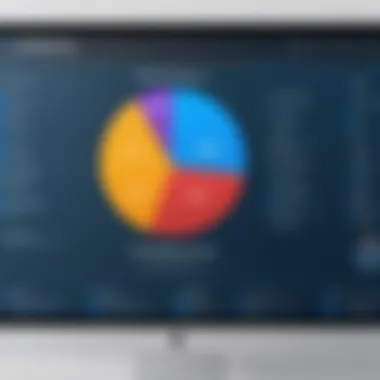Understanding Simple Maintenance Software for Efficiency


Intro
Simple maintenance software is becoming increasingly important for many organizations. It allows businesses to manage their maintenance activities more efficiently. By understanding this software, decision-makers and IT professionals can make informed choices that benefit their operations. This section introduces the core concepts of maintenance software, its relevance, and the essential features it offers.
In various industries, including manufacturing and hospitality, simple maintenance software can play a crucial role. It streamlines processes, minimizes downtime, and reduces operational costs. Organizations using such software can respond faster to maintenance issues. This responsiveness leads to improved productivity and customer satisfaction.
Now, let’s focus on understanding the core features of this software.
Overview of Core Features
Description of Essential Functionalities
Simple maintenance software consists of several key components that enhance its functionality. First and foremost, asset management is vital. This feature allows organizations to track their assets efficiently. Users can view the status, location, and maintenance history of each asset.
Another essential functionality is work order management. This feature helps create, assign, and track work orders. It streamlines the process of scheduling maintenance tasks, ensuring timely completion. Notifications and reminders are often included, reducing the risk of missed tasks.
Preventive maintenance capabilities are also critical. The software can schedule regular inspections and maintenance tasks. This proactive approach prevents equipment failures and extends asset lifespan.
Inventory management is another feature that supports maintenance activity. It allows users to track spare parts and supplies. This capability ensures that necessary items are available when needed, preventing delays.
Comparison of Features Across Top Software Options
When evaluating simple maintenance software, it is important to compare different options. Some popular choices include FMX, UpKeep, and Hippo CMMS. Here are key comparison points:
- FMX offers a user-friendly interface, which helps in easy asset tracking and work order management.
- UpKeep emphasizes mobile access, giving technicians the ability to manage tasks from their devices.
- Hippo CMMS has strong inventory management features, aiding control over spare parts and supplies.
This comparison illustrates that, while all these options serve similar purposes, they have unique features that may cater to specific organizational needs. Adapting to the right software can enhance operational efficiency significantly.
User Experience and Interface
Insights into UI/UX Design Aspects
An intuitive user interface is crucial for the success of maintenance software. Users need to find information easily without confusion. Software that is visually appealing and easy to navigate reduces training time, further enhancing efficiency.
Importance of Usability and Accessibility
Usability goes hand-in-hand with interface design. The software should accommodate various user capabilities. Accessibility options, such as easy navigation and clear instructions, benefit all users, ensuring they can effectively utilize the program.
In summary, understanding simple maintenance software is fundamental for businesses seeking to optimize their maintenance processes. By exploring its core features and comparing available options, decision-makers can select the right tools that align with their operational needs.
Preface to Simple Maintenance Software
Simple maintenance software plays a critical role in today’s operational landscape. As industries increasingly prioritize efficiency, understanding this software becomes essential for decision-makers and IT professionals alike. Its main purpose is to simplify the maintenance management process, allowing organizations to minimize downtime and extend the lifespan of their assets.
Definition and Purpose
Simple maintenance software refers to tools designed to help organizations manage their maintenance tasks efficiently. This type of software encompasses a variety of functionalities, such as scheduling maintenance, tracking work orders, and storing equipment maintenance history. The main goal is to streamline operations and make maintenance processes more systematic.
In this context, simple maintenance software acts as a central hub where all maintenance activities can be tracked and managed. It aids in organizing tasks that are often scattered across multiple platforms or departments. With this software, businesses can establish clear routines, ensure accountability, and allocate resources more effectively. Understanding its definition and purpose is crucial, as it sets the foundation for recognizing its value across various industries.
Importance in Various Industries
The relevance of simple maintenance software spans across diverse sectors. For example, in manufacturing, it helps in managing machinery upkeep, thereby reducing the risk of unexpected breakdowns. In healthcare, this software ensures that critical instruments are maintained properly to meet compliance standards and improve patient safety.
Other industries also benefit greatly:
- Transportation: Simple maintenance software can enhance vehicle upkeep schedules.
- Facility Management: It provides insights into building maintenance cycles.
- Energy and Utilities: This software track maintenance for power plants and distribution systems.
By automating various facets of maintenance management, organizations can see a marked improvement in their overall operational efficiency. Therefore, understanding the importance of simple maintenance software is more than an academic exercise; it has practical implications that drive success in different operational contexts.


"The effective use of maintenance software can drastically reduce downtime and improve asset longevity, proving essential in today's competitive landscape."
With this understanding, we can explore the key features that define simple maintenance software, further clarifying why choosing the right solution is vital for operational excellence.
Key Features of Simple Maintenance Software
Simple maintenance software serves as a vital tool for organizations that require efficient management of maintenance tasks. Understanding its key features is crucial as they not only enhance productivity but also streamline operations. Here, we will take a closer look at several essential features and examine their relevance.
User-Friendly Interface
A user-friendly interface is often the first touchpoint for users interacting with maintenance software. The significance of such an interface cannot be underestimated. A clean layout and intuitive design facilitate easier navigation. This reduces the learning curve associated with new tools, enabling both veteran and novice users to operate the software effectively.
When a system is easy to use, it encourages greater adoption among team members. Complex software can frustrate users, leading to inefficient processes. Hence, an engaging interface usually results in efficient task completion and better data management.
Task Management Capabilities
Effective task management is another cornerstone of simple maintenance software. The ability to quickly create, assign, and track tasks is essential for operational efficiency. Users need to manage a variety of maintenance activities, from scheduled inspections to emergency repairs.
A good maintenance software should allow for priority settings and deadlines, making it easier to manage workloads. This helps in resource allocation, ensuring that critical tasks receive immediate attention while less urgent issues can be scheduled. Furthermore, collaborative tools within the software can improve communication among team members, fostering a culture of accountability and responsibility.
Reporting and Analytics
Reporting and analytics functionalities provide organizations with valuable insights. These features allow users to generate reports on maintenance activities, resource usage, and operational effectiveness. By analyzing this data, decision-makers can identify trends and adjust strategies accordingly.
Detailed reports might include metrics such as average response times, costs associated with maintenance tasks, and compliance with scheduled maintenance. These insights guide informed decisions and assist in budget forecasting, ultimately contributing to improved overall performance.
"A well-designed reporting system transforms raw data into interpretable insights."
Mobile Accessibility
In today's dynamic work environments, mobile accessibility of maintenance software is increasingly important. Technicians often operate in the field, away from traditional office settings. Therefore, having a mobile-compatible solution ensures that users can access crucial information on-the-go.
Mobile functionality means that users can receive real-time updates and communicate effortlessly with the rest of the team. Furthermore, this capability encourages timely responses to urgent maintenance needs. It allows personnel to document their work and provide instant feedback, which can drastically improve workflow efficiency.
Overall, the key features of simple maintenance software play a significant role in enhancing its effectiveness. Decision-makers should prioritize these elements when choosing a maintenance solution to ensure they address their operational needs comprehensively. By focusing on user-friendly interfaces, robust task management capabilities, insightful reporting, and mobile accessibility, organizations can achieve considerable performance enhancements.
Benefits of Using Simple Maintenance Software
As industries evolve, so do their operational needs. Utilizing simple maintenance software can provide organizations a range of advantages that can influence their overall performance. This section explores these benefits, including increased operational efficiency, cost reduction, and enhanced compliance tracking. Each element contributes significantly to how businesses manage maintenance tasks, aligning resources effectively and supporting strategic goals.
Increased Operational Efficiency
Operational efficiency is a critical factor in determining a business’s success. Simple maintenance software streamlines maintenance processes, allowing organizations to allocate resources more effectively. By automating routine tasks such as scheduling, tracking work orders, and managing inventory, maintenance teams can focus on more critical activities. For instance, maintenance personnel can prioritize urgent tasks, reducing downtime and enhancing productivity.
An organized approach ensures that tasks are completed in a timely manner. When everyone knows their responsibilities and deadlines, workflows become smoother. Consequently, simple maintenance software leads to greater job satisfaction among staff. Employees tend to appreciate having clear guidance on their tasks, which reduces frustration and miscommunication.
Cost Reduction
One compelling benefit of implementing simple maintenance software is the potential for cost savings. By optimizing maintenance schedules and reducing downtime, businesses can significantly lower operational costs. For example, preventing equipment failures through timely maintenance can save money on repair costs and prolong asset life. Organizations can thus allocate funds to other strategic initiatives rather than unexpected repairs.
Furthermore, effective inventory management capabilities allow businesses to minimize excess stock. By ensuring the right parts are available at the right time, companies avoid holding surplus inventory, which ties up capital. Other cost-saving features include tracking labor hours and material usage, offering insights into where efficiency can be improved.
Enhanced Compliance Tracking
Compliance with regulatory standards is crucial for many industries, including manufacturing, healthcare, and food services. Simple maintenance software facilitates compliance tracking by automating documentation and reporting processes. This automates the collection of necessary data for audits and inspections, ensuring that organizations meet stringent regulations.
For example, maintenance software can remind users of upcoming inspections or required documentation, reducing the risk of non-compliance penalties. An organized documentation system aids in maintaining records of maintenance activities, which is essential for demonstrating compliance. An organization can quickly access these records during audits, simplifying the verification process.
"The ability to track compliance seamlessly increases confidence in operational integrity and can significantly reduce risks associated with non-compliance."
Challenges in Implementing Simple Maintenance Software


Implementing simple maintenance software presents several challenges that can hinder its effectiveness in an organization. Understanding these challenges is crucial as they help businesses prepare and strategize for a successful software integration. By addressing these areas, companies can maximize the benefits of the software and limit disruptions in their operations.
User Adoption and Training
One of the pivotal challenges in implementing simple maintenance software is user adoption. Resistance from employees can stem from various factors, such as fear of change or lack of familiarity with new technology. To overcome this, organizations must provide comprehensive training. This should include both technical training on how to use the software and education on the benefits of adopting it.
Key considerations for user adoption and training include:
- Initial Training Sessions: Conduct workshops to familiarize users with the software.
- Continuous Support: Establish a support system for users who may encounter difficulties later on.
- Involvement in the Process: Involve end-users in the selection of software. This helps in gaining their buy-in.
- Feedback Mechanisms: Create channels for users to provide feedback during and after implementation to address concerns quickly.
By emphasizing effective training and user involvement, organizations can enhance user acceptance and ensure the successful implementation of simple maintenance software.
Integration with Existing Systems
Another significant challenge lies in the integration of simple maintenance software with existing systems and processes. Many organizations rely on a variety of software solutions and tools. Ensuring compatibility can be laborious. This integration is crucial because fragmented systems can lead to inefficiencies, data silos, and increased operational costs.
Factors to consider when tackling integration issues include:
- Assessment of Current Systems: Evaluate existing tools and processes to identify integration points.
- Choosing Compatible Software: When selecting maintenance software, check its compatibility with other systems.
- API Availability: Look for solutions with robust API support to facilitate smoother integration.
- Testing Phases: Conduct incremental tests to ensure that integration is successful before a full rollout.
Effective planning and thorough analysis of existing systems can mitigate integration problems. These challenges, if managed well, lead to improved workflows and greater overall efficiency.
Effective training and integration strategies are key to maximizing the potential of simple maintenance software.
Choosing the Right Simple Maintenance Software
When selecting simple maintenance software, the choice can profoundly impact operational success. It is more than just picking a tool; it involves understanding the unique needs of the organization. The right software can streamline processes, improve productivity, and ultimately save money. Below, we break down the critical steps in making this critical decision.
Assessing Organizational Needs
Identifying the specific needs of an organization is crucial before diving into software options. Different businesses operate differently and have unique challenges. Consider factors such as the size of your organization, the type of maintenance tasks often performed, and the budget available.
- Size and Scale: Larger organizations may require more sophisticated solutions, while smaller ones might benefit from simpler interfaces.
- Type of Maintenance: Different industries prioritize different maintenance objectives, so understanding which functions are most important can significantly narrow your choices.
- Budget: Knowing how much you are willing to spend upfront and ongoing will help filter options effectively.
Evaluating Software Options
After assessing needs, the next important step is evaluating available software options. Not all maintenance software is created equal, and several factors influence their utility in your specific case.
Comparative Analysis of Features
When comparing different simple maintenance software, establishing a robust comparative analysis of features is essential. Each software solution may offer distinct tools specific to asset management, schedule tracking, and reporting capabilities.
Key Characteristics: The most beneficial software will offer a robust set of features covering most organizational needs. Common elements include task management, reporting, and alert systems.
Unique Feature: One unique feature that may be considered is the customizable dashboard for tracking maintenance performance metrics.
Advantages can include ease of use and the capacity for visual data representation, which can assist decision-making at a glance. However, some software may fall short in integration capabilities, limiting its accessibility across various platforms.
User Reviews and Testimonials
User reviews and testimonials offer invaluable insights into the real-world effectiveness of maintenance software. They can highlight strengths and weaknesses that may not be evident in product descriptions alone.
Key Characteristics: Positive user experiences often indicate reliable performance and effective support, while negative reviews may serve as warnings about potential issues.
Unique Feature: Established patterns in feedback regarding customer service and software reliability can guide decisions in a significant way.
While user reviews provide insights, they can sometimes be skewed due to outlier experiences, so it is important to consider them as part of a broader analysis.
Pricing Models


Understanding the pricing models of various software options is another step in making a well-informed decision. Different financial structures—like subscription-based or one-time purchase—can have implications on overall cost and software longevity.
Key Characteristics: Software with flexible pricing often allows businesses to adapt as they grow, making it a popular choice.
Unique Feature: A unique pricing model might involve a tiered structure based on usage or features, which can help align costs with organizational needs and budget constraints.
This flexibility might be beneficial for startups or smaller businesses, although larger companies may require more comprehensive features requiring higher initial investment.
In summary, choosing the right simple maintenance software goes beyond the software’s technical features. It requires a deep understanding of organizational needs, careful evaluation of options based on features, user feedback, and pricing considerations. This careful approach ensures a well-matched solution that aids in achieving operational efficiency.
Popular Simple Maintenance Software Solutions in the Market
The availability of numerous simple maintenance software solutions plays a pivotal role in fostering operational excellence across various business sectors. Each software offers various features designed to enhance efficiency, reduce costs, and improve compliance. By understanding the options available in the market, organizations can make informed decisions that align with their specific needs.
Top Software Choices
Overview of Leading Applications
When evaluating leading applications in simple maintenance software, it is essential to consider their user interface, integration capabilities, and management features. Maintenance Connection is known for its intuitive design, which allows users to navigate easily without extensive training. This is beneficial for organizations that prioritize user adoption among employees. Another prominent solution, FMX, boasts a robust mobile application that enables real-time communication and task management, ensuring rapid response to maintenance needs. The unique reporting tools in UpKeep also allow for quick access to performance metrics, helping companies identify areas for improvement.
Strengths and Weaknesses
In assessing strengths and weaknesses of popular solutions, an application like Hippo CMMS shines with its extensive customization options, allowing businesses to tailor the software to their workflows. However, the complexity of these options may overwhelm smaller teams without dedicated IT support. Conversely, eMaint is known for its reporting prowess, facilitating data-driven decisions. Yet, some users might find its setup process cumbersome if not approached methodically. Understanding these strengths and weaknesses aids decision-makers in selecting tools that best fit their operational contexts.
Cost Analysis
Cost considerations are critical when selecting simple maintenance software. Assessing the price associated with each software will require more than just a surface-level evaluation. Companies should review not just subscription fees but also potential costs related to training, support, and integration into existing systems. The range of pricing models varies significantly; for instance, Samanage offers a subscription-based model that scales with the size of the organization. In contrast, Fiix uses a more flexible tiered pricing structure that can be advantageous for businesses concerned about initial costs. Firms must judiciously evaluate total cost of ownership, which includes aspects beyond upfront expenses, ensuring the software selected aligns well with both financial and operational goals.
Future Trends in Simple Maintenance Software
Understanding the future trends in simple maintenance software is vital for organizations aiming to stay ahead in a competitive landscape. As technology evolves, maintenance software is also undergoing significant changes to meet the growing demands of businesses. This section examines the integration of artificial intelligence and automation, and the increasing focus on preventive maintenance. Both trends present crucial benefits and considerations for decision-makers and IT professionals.
Integration of AI and Automation
Artificial Intelligence and automation are reshaping the way maintenance software operates. By incorporating AI, systems can analyze data more effectively, predicting failures before they occur. This proactive approach minimizes unexpected downtimes and enhances operational efficiency. AI's machine learning capabilities allow software to adapt to specific patterns in performance, ultimately leading to smarter maintenance strategies.
Automation also contributes significantly to maintenance processes. Routine tasks, such as scheduling work orders or tracking maintenance history, can be automated. This not only saves time but also reduces human error. Maintenance teams can focus on more complex issues, leading to better resource utilization.
Considerations for integrating AI and automation include:
- Cost: Initial investment for advanced systems can be high.
- Training: Staff require training to maximize the benefit of new technologies.
- Data Security: Safeguarding sensitive data is critical as reliance on technology increases.
"The future of maintenance is not only about fixing issues but also about anticipating them through intelligent systems."
Increasing Focus on Preventive Maintenance
Preventive maintenance has gained prominence as a strategy to prolong asset life and optimize performance. With the proliferation of data and technological advancements, organizations can implement predictive maintenance practices more effectively. This approach involves scheduling regular maintenance based on data-driven insights rather than waiting for equipment to fail.
The importance of preventive maintenance lies in its ability to prevent breakdowns and prolong asset longevity. Focusing on this strategy can result in:
- Reduced Unexpected Failures: Knowing when maintenance is needed helps avoid crises.
- Cost Savings: Regular maintenance is often less expensive than emergency repairs.
- Efficiency: Equipment operates more reliably, improving overall productivity.
Organizations should consider investing in tools that facilitate preventive maintenance. These tools can vary based on industry needs but generally include software with strong analytics and reporting features. Such tools not only support maintenance planning but also provide insights necessary for continuous improvement.
In summary, keeping an eye on these emerging trends ensures that maintenance software aligns with the evolving needs of businesses. As AI integration and preventive strategies become common practice, organizations that adapt will likely lead their industries.
Closure
In the realm of maintenance management, the conclusion broadly encompasses the essential themes discussed throughout this article. Understanding the significance of simple maintenance software is crucial for decision-makers and IT professionals alike. This software aids organizations in streamlining operations, reducing downtime, and maintaining compliance with industry standards.
Summarizing Key Takeaways
A synthesis of this discussion reveals several pivotal points:
- Operational Efficiency: Simple maintenance software effectively enhances efficiency. By automating routine tasks, organizations can concentrate resources on strategic objectives.
- Cost-Effectiveness: Proper implementation can lead to substantial cost savings in both labor and material resources.
- Future Trends: With the rise of artificial intelligence and predictive analytics, the landscape of maintenance software is ever-evolving. Keeping abreast of these changes is vital for sustained success.
The Importance of Continuous Evaluation
Continuous assessment of the software's performance and impact is fundamental to maximizing its benefits. Organizations should regularly revisit their maintenance strategies to adapt to technological advancements and changing operational needs.
"Ongoing evaluation ensures that businesses can pivot when necessary, enhancing their adaptability and resilience in a competitive market."



